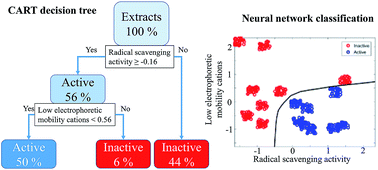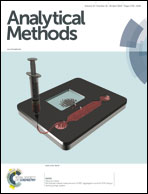Confirmation of the antiviral properties of medicinal plants via chemical analysis, machine learning methods and antiviral tests: a methodological approach†
Abstract
Medicinal plants are reported to possess antiviral activity, but finding the substances that are responsible for antiviral activity in the complex mixture of the plant extract is an extremely difficult task. In this paper a methodology related to the determination of the antiviral properties of medicinal plant extracts and based on phytochemical analysis, antiviral tests and machine learning methods is described. 16 potentially antiviral medicinal plants were selected, and their chemometric characteristics and antiviral properties were investigated. Three different analytical methods were used for chemical analysis: (i) spectrophotometry, (ii) capillary electrophoresis with contactless conductivity detection, and (iii) gas chromatography-mass spectrometry. 14 attributes were obtained describing the composition of the plant extracts. Viral growth inhibition properties were investigated and 8 candidate plant extracts were selected as being active against viruses. Infectious bronchitis virus was used as a model virus. Machine learning techniques including deep neural network classification, classification and regression tree induction and hierarchical clusterization were used for mining the factors that are responsible for antiviral effects. It was determined that (i) phenolic compounds providing high radical scavenging activity and fractions containing high content of phenolic compounds are positively related to antiviral activity in plant extracts, (ii) hydrophilic compounds that are positively charged (pKa > 4.7) in acidic media and possess medium and low electrophoretic mobility properties are negatively related to antiviral activity in medicinal plants, (iii) phenolic acids with pKa lower than 4.7 are not related to antiviral activity in the extracts, and (iv) volatile compounds in the extracts, including diversity, quantity and different volatility properties, do not affect the antiviral activity of plant extracts. Following the proposed methodological approach, it is possible to confirm which chemometric attributes are responsible for antiviral activity in medicinal plant extracts.



 Please wait while we load your content...
Please wait while we load your content...